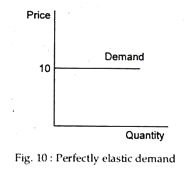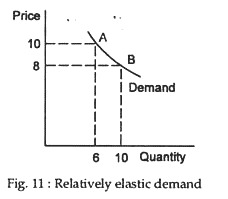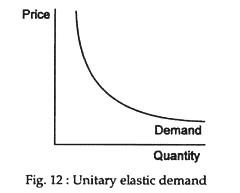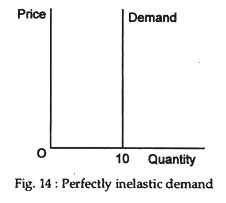In this article we will discuss about the price elasticity of demand. Also learn about the different and various cases of price elasticity of demand.
Elasticity is an important attribute of demand. By elasticity of demand is meant the rate at which the quantity bought changes as the price changes, other things remaining the same.
In the language of Lipsey:
“Demand elasticity is measured by a ratio: the percentage change in quantity demanded divided by the percentage change in price that brought it about; for normal, negatively sloped demand curves, elasticity is negative”.
ADVERTISEMENTS:
In other words, it refers to the degree of responsiveness of the demand for a commodity to a certain change in its own price. It shows the quantitative relationship between the change in the amount demanded for a commodity and the change in its price.
When the price of a commodity changes, other things being equal, the quantity demanded of it changes inversely. But the rate of change in the quantity demanded is not the same in case of all the commodities. It is usually found that the demand for a commodity like salt or rice is not very much affected by a change in its price.
On the other hand, changes in the prices of goods like TV sets or air travel do exert a considerable influence on the demand for them. It means that the rate of change in demand caused by a change in price is different in different commodities. Elasticity of demand for a commodity measures this rate of change in its demand due to a certain change in its own price as shown by the coefficient of price elasticity of demand, Ep, which is:
Ep = percentage change in quantity bought/percentage change in price
ADVERTISEMENTS:
Different Cases or Segments of Price Elasticity of Demand:
The following are the five major cases of price elasticity of demand:
(a) Perfectly Elastic Demand:
In this case, the quantity demanded for a commodity changes infinitely due to a slight or no change in its price. Here, the people ceases to buy it altogether when it rises slightly in price. This is treated as one of the limiting cases of the price elasticity of demand. Here, the elasticity of demand is equal to infinity.
(b) Relatively Elastic Demand:
In such a case, the rate of change in the quantity demanded is greater than that in its price. The demand for luxury articles like air conditioners, cars, refrigerators, TV sets, etc. is relatively elastic. Here, the elasticity of demand becomes greater than (negative) one or unity (but less than infinity).
(c) Unitary Elastic Demand:
The demand for a commodity becomes unitary elastic when the rate of change in the price and that in the quantity demanded become the same. It is neither elastic nor inelastic; it occupies a middle position between the two. Here, the elasticity of demand is equal to (negative) one or unity.
(d) Relatively Inelastic Demand:
In this case, the rate of change in the quantity demanded becomes less than that of a change in the price. The demand for necessaries like rice, wheat, clothes, salt, cigarettes to smokers, etc., is relatively inelastic. Here, the elasticity of demand is less than one (negative) or unity (but greater than zero).
(e) Perfectly Inelastic Demand:
ADVERTISEMENTS:
The demand for a commodity is perfectly inelastic when there is no change in the amount demanded whatever changes may occur in its price. In this case, the people buy the same amount of a commodity irrespective of the price. Here, the elasticity of demand is equal to zero. This is also another limiting case of price elasticity of demand.
Perfectly Elastic and Perfectly Inelastic Demand:
ADVERTISEMENTS:
Perfectly elastic demand and perfectly inelastic demand are the two extreme limiting cases of the price elasticity of demand, and as such as rarely found in the real world. In the case of a perfectly elastic demand, the people cease to buy the commodity altogether in case of a slight rise in its price.
The demand for the product of an individual firm under perfect competition is perfectly elastic, for a competitive firm will not find any buyer in the event of a slight increase in the price for its product. A perfectly inelastic demand denotes, on the other hand, the same amount of demand for a commodity at all prices. In this case, the people demand the same quantity of a commodity whatever its price may be. This type of price elasticity of demand is also rarely found in actual practice.
The Value of Price Elasticity on a Straight Line Demand Curve:
The value for elasticity will usually be different at every point on a demand curve. This must be the case because the formula makes use of the initial price and quantity as well as the changes in each. As we take different points on the demand curve, we have different starting points (or initial values) for price and quantity.
ADVERTISEMENTS:
So, the value for elasticity will differ. This may be illustrated with reference to Fig. 15. Using the figures from the demand curve given in Fig. 15 we shall measure elasticity with regards to: (a) a fall in price from 15 p to 14 p, (b) a fall in price from 10 p to 9 p and (c) a fall in price from 5 p to 4 p.
ADVERTISEMENTS:
We see that although ∆Q and ∆P are the same in all three cases, the value for elasticity is different in each case. With a downward-sloping straight line demand curve, price elasticity falls as one moves down the curve from left to right.
The reason for this is that, at the upper end of the demand curve the original price is very high and the original quantity is very small. So, a small drop of price leads to a large (i.e., more than proportionate) change in quantity and demand is price elastic. By contrast, in the lower part of the demand curve the original price is low and the original quantity is very large. So, a large drop in price is necessary to induce a small (i.e., less than proportionate) increase in quantity and drop in price inelastic.
ADVERTISEMENTS:
So, elasticity depends on the slope of the demand curve and the point at which the measurement is made. Starting at point A and moving to point B, the ratio ∆P/∆Q is the slope of the line, while its reciprocal ∆Q/∆P is the first term in the percentage definition of elasticity.
The second term is P/Q, which is the ratio of the coordinates of the point A. Since the slope ∆P/∆Q is constant, it is clear that the elasticity along the curve varies with the ratio P/Q, which is zero where the curve intersects the quantity axis and infinite where it intersects the price axis.
Shape of the Demand Curve having Unitary Elasticity:
Each of the demand curves shown in Fig. 16 has a constant elasticity. D1 has zero elasticity: the quantity demanded does not change at all when price changes. D2 has infinite elasticity at the price P0: a small price increase from P0 decreases quantity demanded from an indefinitely large amount to zero. D3 has unit elasticity: a given percentage increase in price brings an equal percentage decrease in quantity demanded at all points on the curve; it is a rectangular hyperbola for which price times quantity is a constant at all points.







